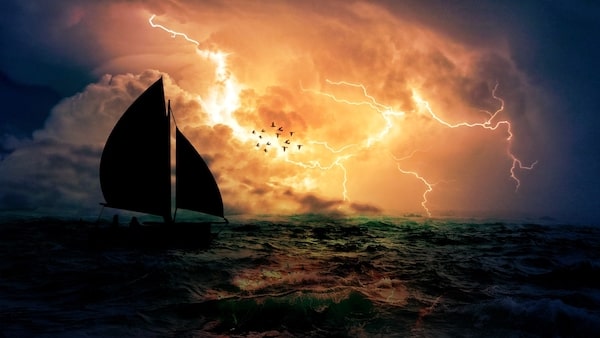Let’s use the analogy of a storm at sea as the same as relationship conflict.
I don’t sail, but I have played some computer games about sailing. When I see the storm out at sea I have several options: 1) lower my sails and wait and see what happens, 2) Turn tail and sail back to home port, 3) cautiously sail into the storm, risking getting bashed, 4) recklessly sail into the storm and be at great risk 5) spend significant time tacking around the storm and risk getting bashed anyway.
When we anticipate conflict with our partner, we have a lot of options about how to proceed…
 Lowering my sail is what I call “passive avoidance.” I may wait for the issue to go away. I may wait for my partner to take an action that will resolve things. Some reasons I may wait include fear, anticipation or paralysis. The problem is, my hopes and wishes may not come true and the storm may chase me down anyway. And, later when the issue comes to light, I may be judged as cowardly.
Lowering my sail is what I call “passive avoidance.” I may wait for the issue to go away. I may wait for my partner to take an action that will resolve things. Some reasons I may wait include fear, anticipation or paralysis. The problem is, my hopes and wishes may not come true and the storm may chase me down anyway. And, later when the issue comes to light, I may be judged as cowardly.
Returning to port is what I call “active avoidance.” It has the same problems as above. Spending time going around the issue has the same problem as the above and it may result in additional work and frustration. It may also be seen later as a very manipulative or slippery way of avoiding something.
You can see where I’m going…
If I sail into the storm with caution, I have a chance of getting through it with my eyes open, sails working and my crew with me.
With couples in my office, I see hundreds of reasons why an individual won’t sail into the storm. I imagine you became aware of some of yours as you read this.
The most common one I hear is about the history of how things went bad when someone tried to talk about a difficult issue and then the belief that it won’t go well the next time either. This results in distance, lack of intimacy, and ultimately, dishonesty, by virtue of withholding. This is, of course, just fear at work. When we do couples therapy and improve communication and experience some small gains in my office, it becomes easier to risk outside of the office. If things do go poorly, we talk about it at the next therapy session and look at where it went wrong. It’s this trial and error (with guidance and focused awareness) that creates lasting change.
I see couples weather much more severe storms than they ever thought they could. When they come out of several experimental storms feeling more intimate, therapy ends very soon after that.
Click to download a copy of Sailing Into The Conflict.

Leave A Comment